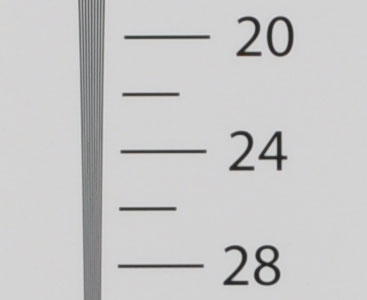Olympus E-620
-
-
Written by Gordon Laing
Studio resolution: Olympus E-620
Olympus E-620 results : Real-life resolution / Studio resolution / High ISO Noise vs 500D / T1i and D5000
Horizontal resolution using in-camera JPEGs
Olympus E-620 with Zuiko Digital 14-42mm |
Olympus E-520 with Zuiko Digital 14-42mm | |
 |  | |
2350 lpph, 14-42mm at 25mm at f8, 100 ISO |
2150 lpph, 14-42mm at 25mm at f8, 100 ISO | |
Canon EOS 500D / T1i with EF-S 18-55mm IS |
Nikon D5000 with Nikkor DX 18-55mm VR | |
 |  | |
2400 lpph, 18-55mm at 35mm, f8, 100 ISO |
2250 lpph, 18-55mm at 35mm, f8, 200 ISO |
Vertical resolution using in-camera JPEGs
Olympus E-620 with Zuiko Digital 14-42mm |
Olympus E-520 with Zuiko Digital 14-42mm | |
 |  | |
2350 lpph, 14-42mm at 25mm at f8, 100 ISO |
2150 lpph, 14-42mm at 25mm at f8, 100 ISO | |
Canon EOS 500D / T1i with EF-S 18-55mm IS |
Nikon D5000 with Nikkor DX 18-55mm VR | |
 |  | |
2400 lpph, 18-55mm at 35mm, f8, 100 ISO |
2250 lpph, 18-55mm at 35mm, f8, 200 ISO |
Olympus E-620 Studio resolution: JPEG versus RAWWe photographed our test chart in the E-620’s RAW plus Large Fine JPEG mode, allowing us to directly compare images created from exactly the same data. Below are crops taken from the original JPEG file alongside the RAW version, processed in the supplied Olympus Master 2.11 software using the default settings. Spot any difference? No, not us either. Despite a minor variation in brightness, the converted RAW file is once again essentially identical to the in-camera JPEG and shares the same resolution. Interestingly this is the same result we found with the earlier E-520, where RAW files converted using Olympus Master using the default settings were pretty much identical to in-camera JPEGs. Of course tweaking the settings may deliver superior results, and shooting in RAW still gives you greater flexibility when it comes to adjusting things like White Balance, but sadly we’re not seeing a boost in quality here with the defaults. Now let’s check out the camera’s performance at different sensitivities in our Olympus E-620 High ISO noise results page. |
Olympus E-620 with Zuiko Digital 14-42mm: JPEG |
Olympus E-620 with Zuiko Digital 14-42mm: RAW | |
 |  | |
2350 lpph, 14-42mm at 25mm at f8, 100 ISO |
2350 lpph, 14-42mm at 25mm at f8, 100 ISO | |
Olympus E-620 with Zuiko Digital 14-42mm: JPEG |
Olympus E-620 with Zuiko Digital 14-42mm: RAW | |
 |  | |
2350 lpph, 14-42mm at 25mm at f8, 100 ISO |
2350 lpph, 14-42mm at 25mm at f8, 100 ISO |
Olympus E-620 results : Real-life resolution / Studio resolution / High ISO Noise vs 500D / T1i and D5000

|
In terms of resolving power, the Olympus E-620 delivers 2350 lpph of horizontal and vertical resolution when equipped with the Zuiko Digital 14-42mm kit lens. This score is a little higher than the Nikon D5000 despite having roughly the same total pixel count, because its pixels are arranged in a squarer 4:3 frame – so there’s more of them in the vertical axis, and here we’re measuring lines per picture height. Interestingly we measured a slightly higher figure for the Panasonic Lumix G1 though which shares roughly the same sensor resolution.
The E-620’s scores are however comfortably higher than the earlier E-520 which scored 2150 lpph when fitted with the same 14-42mm kit lens. The Canon EOS 500D / T1i scores slightly higher still, but is quite close because again we’re only considering its vertical resolution here, which is only a little higher than the Olympus due to the frame shapes.
It’s still a good result for the E-620 though in terms of technical resolving power, but has this increased pixel-density had a detrimental effect on noise levels? Find out on the next page in our High ISO Noise results page. Alternatively, scroll down to the bottom of this page where you’ll see whether shooting in RAW can extract a little more from the sensor.



